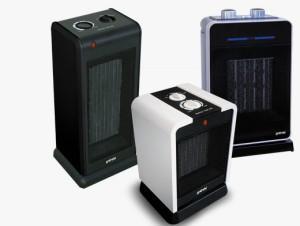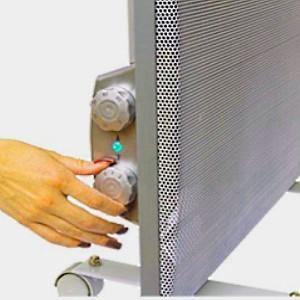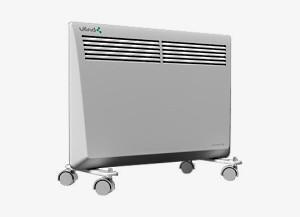Which heaters do not burn oxygen and do not dry air
 Safety is one of the most important criteria for choosing a heater. This is especially true when buying a heater for a children's room. In this case, modern heaters that do not burn air are ideal.
Safety is one of the most important criteria for choosing a heater. This is especially true when buying a heater for a children's room. In this case, modern heaters that do not burn air are ideal.
Air quality directly depends on the type of heater. The level of oxygen combustion from exposure to heat rays can be increased, which negatively affects human health (especially a child).
Oxygen is burned by those heaters that have an open coil (electric and gas heat guns), fan heaters or a heating element (heaters, the coil of which is wound on a ceramic base), an open flame (fireplaces). Such devices burn not only oxygen, but also dust particles that fall on them, which provokes the release of toxic gases.

Modern trends in the production of heating devices either completely exclude the combustion of air, or burn a low percentage of it. What kind of heaters do not burn oxygen?
Related article: country quartz heaters!
There are several models that are recommended for heating the premises of a house or summer cottage:
- Convection.
- Infrared.
- Ceramic.
- Oil.
 Convection heaters... Thanks to the built-in radiator, electric convectors do not burn oxygen at all. Its principle of operation is based on heat exchange: the passage of cold air from the room through the lower air intake grille, then the air passes through the heated radiator and comes out already warmed up to the set temperature. Convectors do not have fans - warm air comes out of it in a natural way, without disturbing the balance of room humidity. The convector body itself remains unheated.
Convection heaters... Thanks to the built-in radiator, electric convectors do not burn oxygen at all. Its principle of operation is based on heat exchange: the passage of cold air from the room through the lower air intake grille, then the air passes through the heated radiator and comes out already warmed up to the set temperature. Convectors do not have fans - warm air comes out of it in a natural way, without disturbing the balance of room humidity. The convector body itself remains unheated.
It should be noted that an excellent sign of the environmental friendliness of the heater is the slowness of heating. If the air temperature in the room begins to rise sharply, this may indicate an imbalance in humidity, which is not important for health.
 Infrared heaters... These heaters do not dry the air as well as convectors. But according to the principle of action, they differ from each other. When an infrared heater is in operation, it is not air that heats up, but objects. Then the room heats up from them. There are long-wave heaters (micathermic, ceramic panel, air conditioner) and shortwave (lamp, ceramic infrared systems). The rays of an infrared heater are not capable of burning humans and the environment, therefore, in terms of heaters, they are optimal and inexpensive.
Infrared heaters... These heaters do not dry the air as well as convectors. But according to the principle of action, they differ from each other. When an infrared heater is in operation, it is not air that heats up, but objects. Then the room heats up from them. There are long-wave heaters (micathermic, ceramic panel, air conditioner) and shortwave (lamp, ceramic infrared systems). The rays of an infrared heater are not capable of burning humans and the environment, therefore, in terms of heaters, they are optimal and inexpensive.

Ceramic heaters... If we talk about ceramic models, then it should be noted that they have a closed heating element, due to which such heaters do not dry the air. The heating element itself is hidden in a ceramic shell, which is much more neutral in relation to oxygen than any other metal surface. The air will not oxidize, which helps to maintain sufficient humidity.
To increase heat transfer, the so-called ribbing is used (creating a relief surface). As a result, the surface of the ceramic heater does not get very hot. This principle of heat removal helps prevent oxidation of the air, which means its drying.

Oil heaters... The principle of operation of oil heaters is based on heating the oil that is inside and creates the required temperature regime. But they are the most unsafe and uneconomical. It does not take much time to warm up, but it consumes a fairly large amount of electricity (up to 3 kW / h). When the device heats up, its body also warms up. If you are not careful enough, you can get burned, therefore it is strictly not allowed to leave it unattended, for fire safety purposes. The oil heater does not burn oxygen, it can be used in the room for operational heating.
Heater selection
 Homeowners and summer residents who are faced with the problem of choosing a heater recommend purchasing modern infrared heaters. It is this heating principle that is currently the most effective. There are types and models that are more expensive, and there are also cheaper ones. But they all boil down to the main indicators - gradual heating and preservation of normal air humidity.
Homeowners and summer residents who are faced with the problem of choosing a heater recommend purchasing modern infrared heaters. It is this heating principle that is currently the most effective. There are types and models that are more expensive, and there are also cheaper ones. But they all boil down to the main indicators - gradual heating and preservation of normal air humidity.
When choosing a heater, you need to pay attention to reliable and proven brands. These include the products of UFO, AEG and the international holding Polaris. A wide range of models will allow each person to choose the right product.
When purchasing a heater, you should pay attention to a number of additional qualities and functions. It is also necessary to attach great importance to the safety of the device (availability of protection against voltage drop, thermostat, grounding).
Throughout the entire period of using the device, the basic requirements for its operation should be met, then it will serve trouble-free and for a long time.
We bought a convector for heating the child's room. We vibrated between the IR heater and the convector, the store said that the convector is better, that it dries the air less. We are pleased with our purchase, the room heats up quite quickly, especially since the room is small.
What does “burn oxygen” mean, can you explain? Where does oxygen go if the spiral is open?
It is very difficult to burn oxygen. It burns only in fluorine vapor. And the term “burn oxygen” probably means excessive air drying, that is, removing water vapor. After all, with dry air, it is hard to breathe. It is not in vain that they even recommend humidifying the air in the room in winter, otherwise flowers and vegetable seedlings feel worse.
Combustion, or incineration, is a process in which a chemical element is oxidized by oxygen. In a city apartment, dust can be burned, which is mainly dead particles of human skin.
When a room is heated with an electric heater, infrared heat waves increase the ability of dust particles to oxidize with oxygen, which leads to the appearance of a specific odor. Of course, oxygen is consumed in this process, probably by manufacturers, and this factor is called "oxygen combustion".
But the fact that closed heaters do not "burn oxygen" is another publicity stunt. It's just that closed devices begin to oxidize dust later, and this process is slower. But if you leave both types of heaters in the room on for at least a day, the effect will be the same.
Nonsense, appliances without an open flame burn nothing, except for dust falling on hot surfaces. The text was written by managers who did not study physics at school, the law of conservation of energy and mass. There is no dehumidification of the air or combustion of oxygen. Air humidity changes with temperature, and oxygen burns together with dust only on open spirals, but the loss of oxygen from this process is negligible compared to its consumption by humans ...